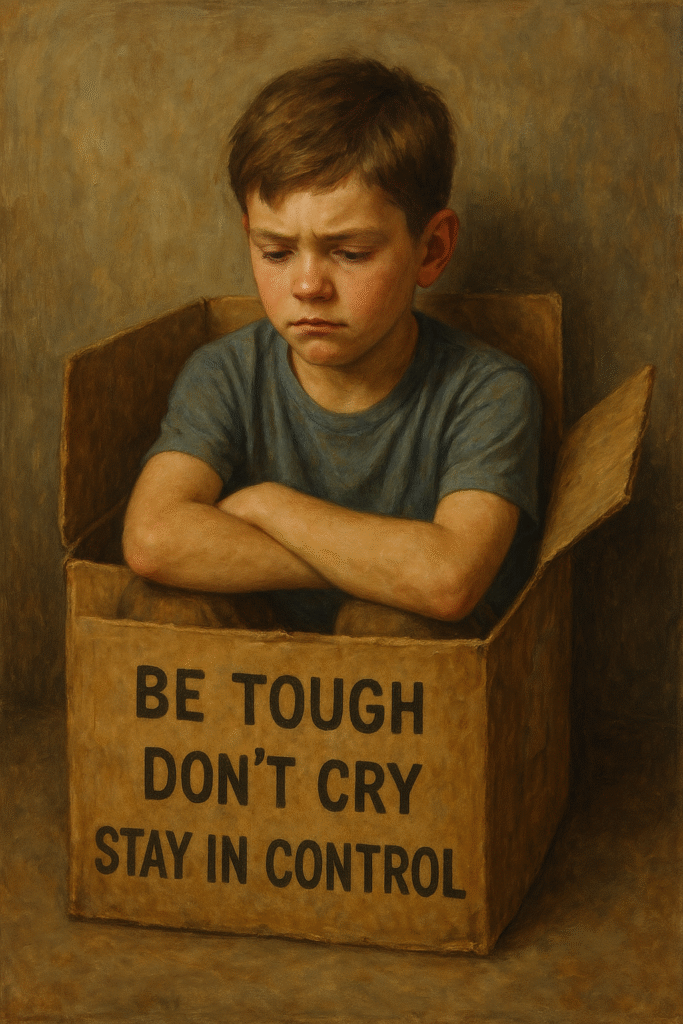1. Introduction: What is the Man Box?
From the moment we’re born, we’re wrapped in blue blankets and given messages that tell us how to act, how to feel, and what it means to “be a man.” The “Man Box” is a term used to describe a rigid set of expectations placed on boys and men—expectations that limit emotional expression, glorify dominance, and pressure men into roles that often isolate and harm them and others around them.
Coined by Paul Kivel and popularized through Promundo’s research, the Man Box represents a cultural code that shapes male behavior from early childhood. It encourages traits like stoicism, dominance, self-reliance, and the repression of emotions, especially those seen as “weak.” It also devalues traits such as empathy, vulnerability, and emotional expressiveness.
The Man Box isn’t something we’re born into. It’s something we’re trained into—by media, school, family, religion, peers, and even our own fears.
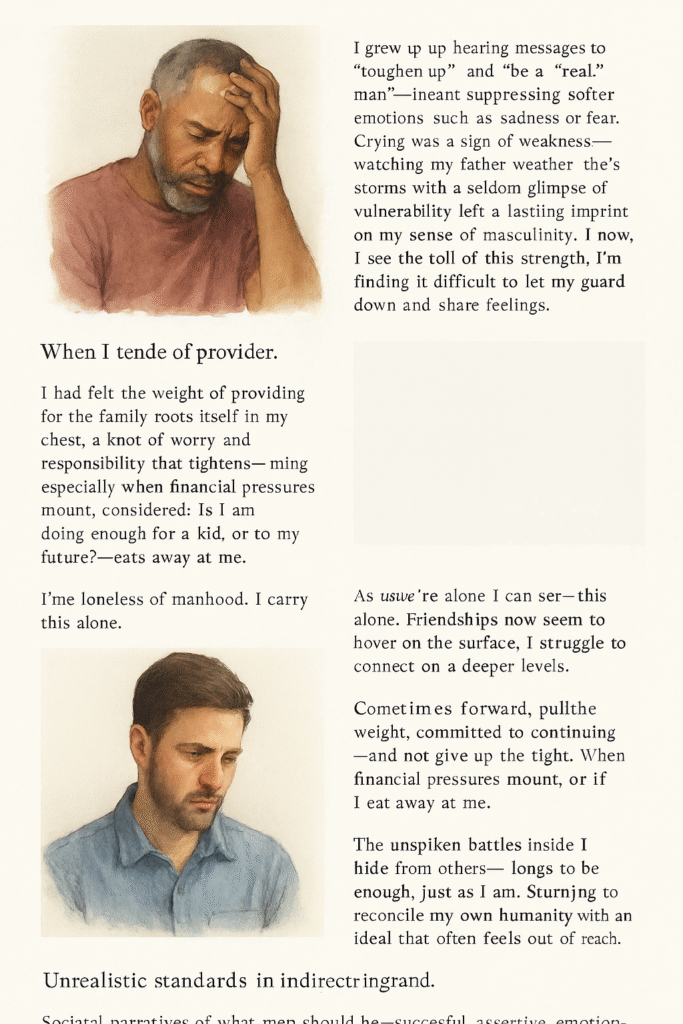
2. The Seven Pillars of the Man Box
The Man Box isn’t arbitrary. It operates according to a system—seven interlocking beliefs or “pillars” identified through global studies, including those by Promundo, as well as recent academic work in Jordan and Australia:
- Emotional Suppression: Boys are taught to hide emotions like sadness, fear, or tenderness.
- Aggression and Dominance: Boys must prove their manhood through strength, sometimes even violence.
- Heterosexual Compulsion: Boys are expected to show interest in girls, and only girls.
- Control Over Women: Power dynamics in relationships are often skewed in favor of the male.
- Risk-Taking: Recklessness is applauded; caution is seen as cowardice.
- Homophobia and Misogyny: Traits deemed feminine or gay are ridiculed or punished.
- Self-Sufficiency: Dependency is weakness. A man must do it alone.
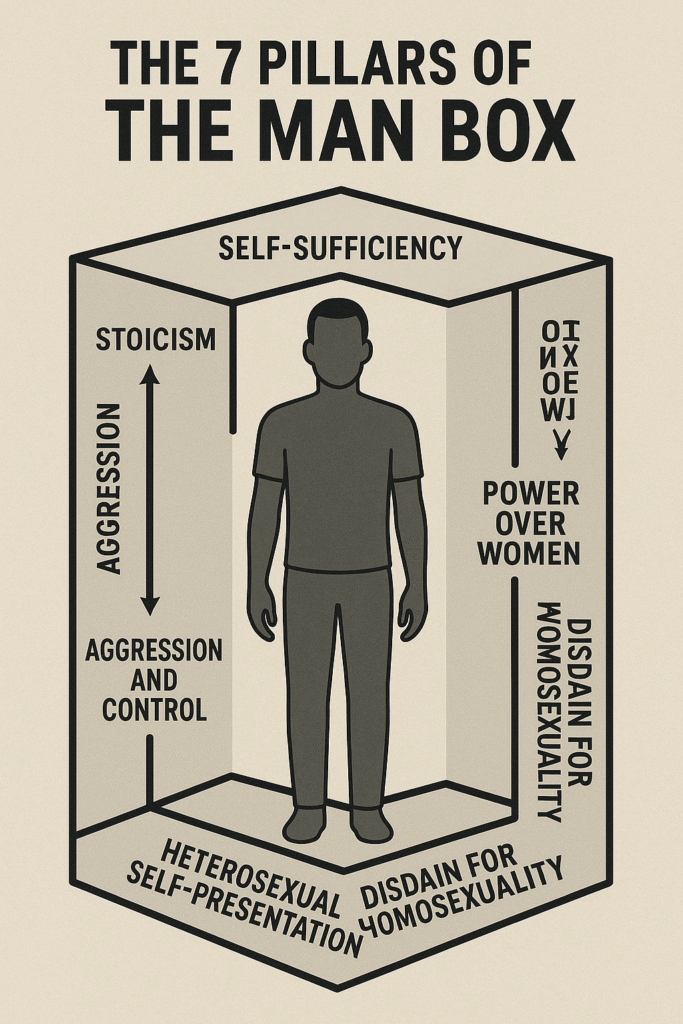
These ideals are harmful not just because they restrict male behavior, but because they become internalized. Over time, many men don’t even realize they’re stuck in the box.
3. Socialization: How Boys Learn the Rules
Children don’t learn these rules in isolation. From toddlerhood, boys are guided—sometimes subtly, sometimes violently—into conformity. A boy cries after falling? He’s told to “shake it off.” He likes painting? He hears, “That’s not for boys.”
By school age, masculinity becomes policed by peers. Sensitivity becomes a liability. Softness becomes a slur. Physical prowess, sexual conquest, and emotional detachment become currencies of approval.
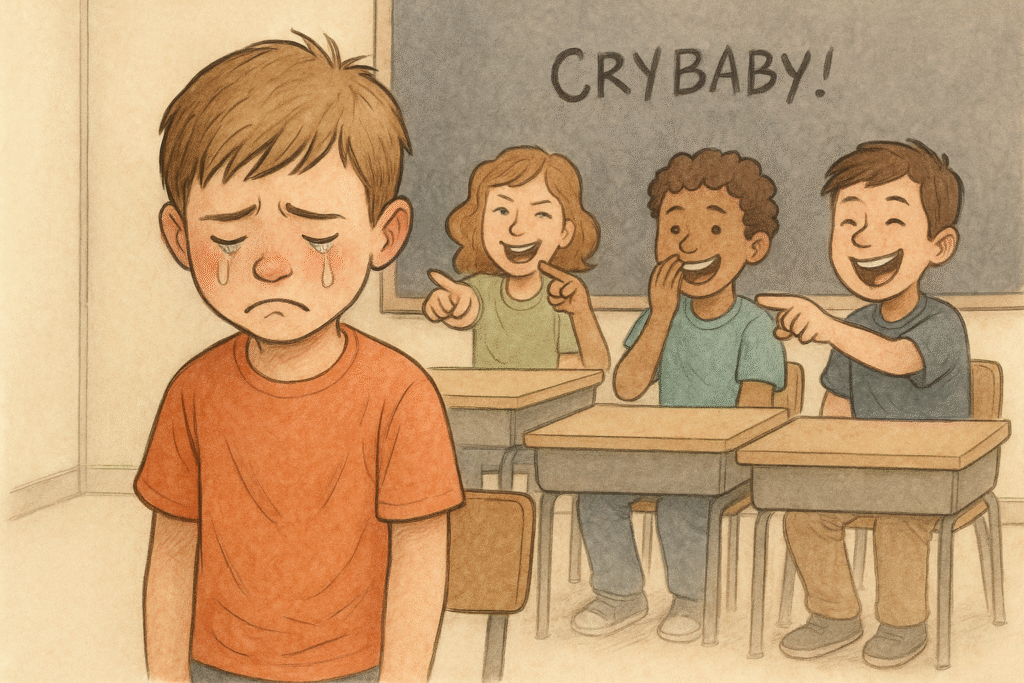
Fathers and male role models often unknowingly reinforce these roles. Many believe they are preparing boys for a hard world. But instead, they create a world where boys disconnect from their own humanity.
Mothers and sisters may also enforce the Man Box—not because they intend harm, but because these norms are deeply embedded in their own upbringing.
In Jordan, research by Alsawalqa (2023) shows how even women help socialize boys into dominance and emotional suppression, often out of fear that anything else will make them vulnerable.
4. The Psychological Toll of the Man Box
When boys are taught to suppress emotion, what happens to those emotions?
They don’t disappear. They become bottled up, redirected, or disguised—usually as anger or numbness. Over time, this creates a dangerous emotional cocktail: high stress, poor communication skills, and a sense of isolation.
Numerous studies link traditional masculinity norms to depression, anxiety, substance abuse, and suicide. In Australia, suicide remains the leading cause of death for men aged 15 to 44. Men are three times more likely to die by suicide than women, despite lower diagnosis rates for depression. Why? Because many never seek help.
Addiction, rage, violence, and self-harm become the symptoms of a deeper emotional imprisonment. These aren’t personality defects. They’re the result of conditioning.
5. From Emotional Repression to Domestic Violence
When a man cannot express fear, sadness, or vulnerability, what tools are left to him in a moment of relational stress? Often, it’s dominance, coercion, or violence.
The Man Box doesn’t just damage the man inside it—it harms those around him. Partners, children, coworkers, strangers. Emotional repression can evolve into a cycle of emotional abuse, gaslighting, possessiveness, and in worst cases, physical violence.
In a Jordanian study, 60.5% of male participants believed emotional abuse was justified in certain scenarios. Many had experienced childhood trauma, with physical punishment and neglect playing a major role. Abuse, then, became not just a learned behavior—but an identity.
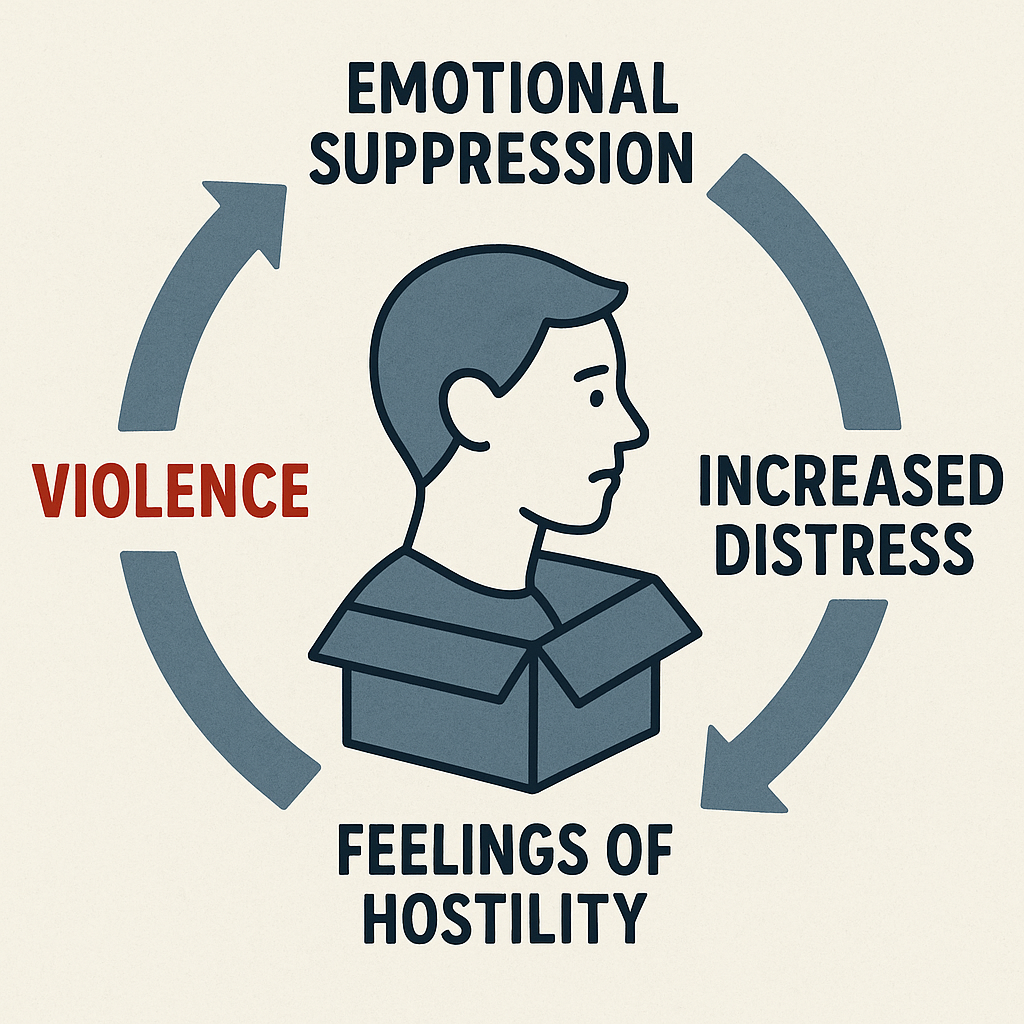
6. The Man Box Across Cultures: A Comparative Lens
| Country | Key Traits of the Man Box | Common Consequences | Reinforcement Mechanisms |
|---|---|---|---|
| Jordan | Religious and patriarchal dominance | High emotional abuse, gender inequality | Family, religion, social status |
| Australia | “Lad culture”, anti-femininity, stoicism | Suicide, IPV, emotional shutdown | Media, sports, peer pressure |
| United Kingdom | Stiff upper lip, homophobia, emotional silence | Relationship breakdowns, loneliness | School, media, historical masculinity norms |
While the themes remain the same, the cultural enforcement methods differ. Jordan, for example, uses religious and moral frameworks to legitimize control. Australia uses humor and hypermasculine role models. The UK focuses on tradition and silence.
In all cases, however, the box leaves little room for healthy identity formation.
7. The Role of Women, Mothers, and Communities
Women are not to blame for the Man Box—but they often uphold it. A mother might tell her son not to cry to protect him from bullying. A sister might tease her brother for being emotional. A partner might expect her man to “be strong” even when he is suffering.
Breaking free requires everyone to examine their roles. Empowering women means helping them stop expecting men to be unbreakable. It means understanding that emotional expression is not weakness but strength.
Communities need to shift from shaming boys into manhood to nurturing their emotional complexity. This requires rethinking discipline, education, religion, and relationships.
8. Redefining Masculinity: Freedom Outside the Box
Imagine if masculinity wasn’t about power, but purpose. If boys learned that courage means speaking the truth even when your voice shakes. That responsibility includes making others feel safe. That being a protector doesn’t mean dominating, but supporting.
We need to redefine strength. Real strength is emotional fluency. Real leadership is compassionate. Real men listen, feel, and grow.
This doesn’t mean rejecting masculinity. It means evolving it. Expanding it. Turning it into something that serves instead of suffocates.
9. SafeManhood: A New Model for Raising Boys and Healing Men
At SafeManhood, we believe that change is possible when it begins at home and extends to every corner of society. Here are our key pillars of action:
- Education: Curriculum reform to teach boys emotional intelligence, healthy masculinity, and empathy.
- Support Networks: Creating safe spaces for men to share, heal, and grow together.
- Parenting Workshops: Guiding parents to raise emotionally balanced sons.
- Public Campaigns: Challenging the toxic norms in media, advertising, and pop culture.
- Male Allyship: Training men to be allies in preventing domestic violence and promoting gender equality.
[Image Placeholder: Group of men sitting in a healing circle or community meeting.]
These aren’t abstract ideals. They’re already working in schools, communities, and families where the Man Box is being dismantled.
10. Conclusion: Beyond the Box
You are not your silence. You are not the rage you carry from childhood. You are not the stoic man you were told to be. You are allowed to cry, to love, to fear, to ask for help. And you are responsible for what you choose to do next.
“You are not the worst thing you’ve done. But you are responsible for what you do next.”
Break the box. Be free.
Join the SafeManhood movement. Raise boys who feel. Support men who heal. Build communities where masculinity isn’t a cage, but a canvas.

